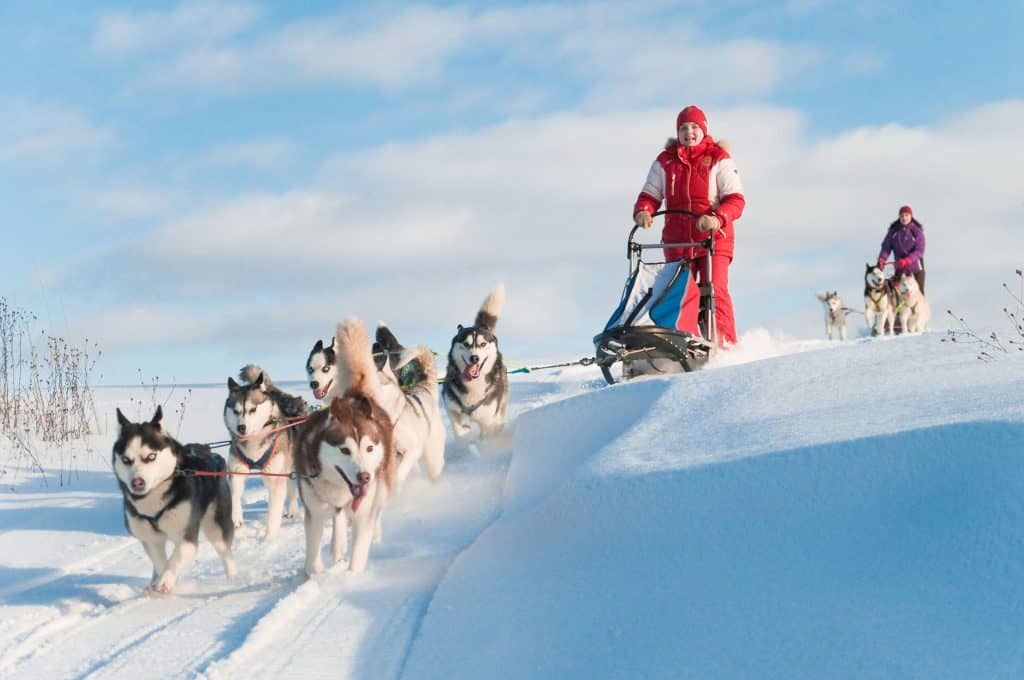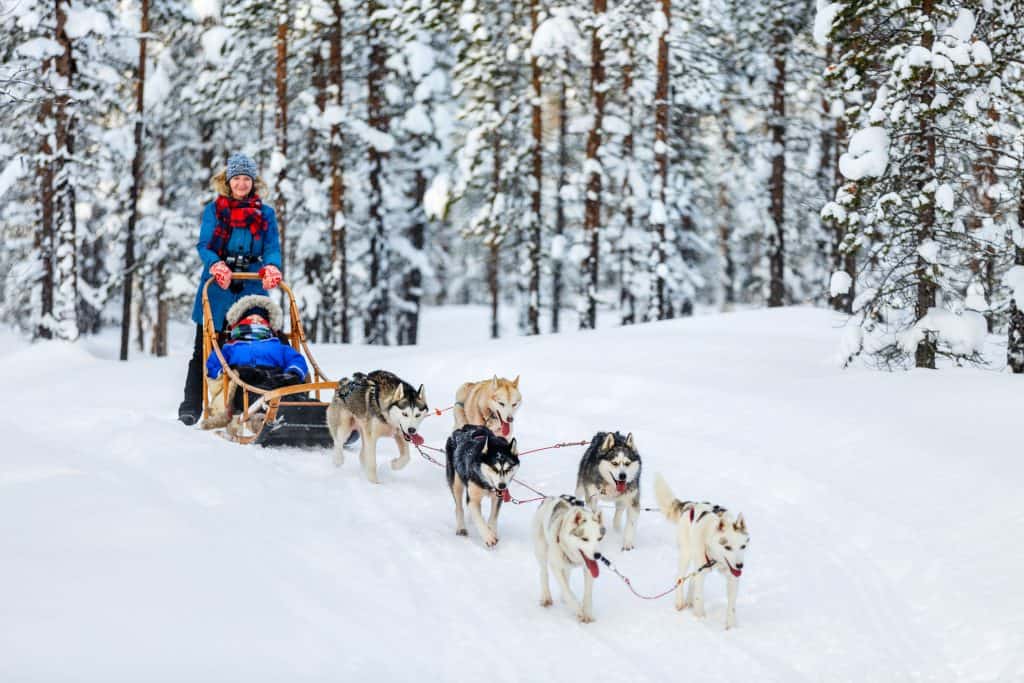
When many think of dog sledding, they think of the incredible story of Balto and memories of the Disney movie may flood into their minds. However, dog sledding has a long history that draws its start long before Balto.
Dog sledding is estimated to have originated 3,000 years ago in what is now know as modern-day Siberia. The earliest records date back to 1,000 AD. Dog sledding was also used by the Inuit in Northern Canada long before European settlers arrived.
Europeans settlers eventually arrived on the North American continent and found a culture that had the practice of dog sledding deeply rooted in their everyday lives.
A Deeper Look at the History of Dog Sledding
There is a long history of companionship between man and dog. As humans, we have been using dogs to help us hunt, herd, and make travel easier for thousands of years.
In fact, there is evidence of domesticated dog use on the Island of Zhokov in Siberia that dates back 9,000 years!
When it comes to dog sledding, the earliest known record dates back to around 1,000 AD. However, archaeologists have found evidence that suggests that dog sledding was used in Siberia over 3,000 years ago.
Much of the history that we know about dog sledding comes from the Inuit People in Northern Canada, which greatly pre-dates any European contact.
Dog sledding was deeply woven into the culture of the native Inuits.
They had been utilizing dog sleds as a way to transport food and supplies. Their type of dog sledding looked a lot different than what we know dog sledding to be today.
They normally loaded sleds up with a minimal amount of cargo (normally firewood or food) and only had one to three dogs pulling it. Dog sledding was a way of life and greatly enhanced the Inuits way of life.
It was not a sport, which is often what people think now when they think of sledding.
Dog Sledding is Introduced to Colonists
Upon arrival to the North American continent, colonists and explorers were intrigued to find a culture that had been using the practice of dog sledding for many years. These colonists slowly began to learn dog sledding and adopt its use.
Not only did they do this in the new land they had moved to, but they also took it back to Europe.
Russian explorers are credited with “modernizing” dog sledding and making it more efficient. They were first introduced to dog sledding in the 1700s and recognized its usefulness in their own land because of their climate.
They eventually began to arrange the sled dogs in pairs or single file lines, which was much different from the Inuits traditions.
The Russians also trained a lead dog to take specific commands, thus maximizing the effectiveness of dog sledding. In addition to that, they used as many as 16 dogs in a team.
The Russians gave each of the dogs a specific place in the line-up and trained them according to their place. Doing this allowed the Russians to increase the size of a load that a dog sled team could transport.
Colonists in the Americas also used dog sleds to their advantage.
Surprisingly, they were used by the Canadian military during the Seven Years’ War (1754-63) to transport food, goods, and military equipment.
Sled dogs were also greatly used in the late 19th century during the Alaskan Gold Rush. A large number of “gold camps” were established by settlers hoping to find gold and make a fortune. During the winter, many of these gold camps were only accessible through the use of dog sled.
In fact, if it weren’t for the sled dogs, the towns established by the Alaskan Gold Rush never would have been able to exist.
Dog sledding in Alaska was very critical!
Believe it or not, up until 1963, mail delivery in Alaska was done primarily through the use of sled dog. Around 500 to 700 pounds of mail were loaded onto each sled and hauled by a team of eight to ten dogs. It was found that the dogs were actually much more efficient to use during winter conditions than boats, trains, or horses.
As mentioned earlier, the use of dog sledding caught on in many other parts of the world. It was used in places like Greenland, Siberia, Norway, Finland, and even Antarctica.
The first Arctic explorers used sled dogs and eventually, Ronald Amundsen (a Norwegian explorer) became the first person to reach the south pole, thanks to the use of dog sleds.
Visit Our Winter/Snow Page for More Great Content!
Racing
Historically, dog sledding has always had a sort of casual rivalry to it. The first formal dog sled race was held in 1908 in Nome, Alaska.
Ten years later this race would become legendary as it follows a similar route that was made by Leonhard Seppala and his dog Balto. Today, there are multiple dog sled races are held in Canada, the U.S., and Europe.
Iditarod
The Iditarod is perhaps the most well-known and famous dog sled race in the world.
It is an annual long-distance race that follows a 938-mile course from Anchorage, AK to Nome AK. It started in 1967 and the route was changed in 1973 to make the race much more intense and difficult.
Finnmarkslopet
The Finnmarkslopet is a race that was established in 1981 and directly inspired by the Iditarod.
The route is 600 km – 1200 km and goes across Finnmark in northern Norway. It is Europe’s longest and hardest race.
La Grande Odyssee
This racing event is a fairly new one, it was started in 2005 and goes through the French and Swiss Alps. The international contestants follow a 900 km route that winds through the beautiful Alp mountains in Europe.
Yukon Quest
The Yukon Quest is considered to be the most difficult dog race in the world. Its 1,000-mile route is from Fairbanks, AK to Whitehorse, Yukon.
In this race, mushers follow old routes that were commonly used back in the heyday of dog sledding. Conditions in this race are known to get very dicey, which is why it is considered the most difficult race in the world.

Famous Sled Dogs
Balto and Togo
The most famous event in the history of modern dog sledding was the “Great Race of Mercy”. In 1925, there was an outbreak of diphtheria in the small Alaskan town of Nome. Nome had run out of the antitoxin that could save hundreds of people. The nearest serum was in Nenana, Alaska.
The antitoxin was unable to be delivered past Nenana and the only option was to retrieve it by using sled dogs.
Both Togo and Balto were the lead dogs that assisted in bringing the antitoxin from Nenana to Nome (a 674-mile route) in just six days. This event was so popular when it happened that there is even a statue of Balto in Central Park.
Anna
Anna was a small Alaskan Husky who took over the role as the lead dog on an expedition in Arctic Coast. The reason why Anna is such an important dog in dog sledding history is that she assisted Pam Flowers in being the first woman to cross the Arctic alone.
Pam Flowers and her team of dogs (led by Anna) covered a distance of 2,500 miles in the course of 11 months in 1993.
Dog Breeds Used for Dog Sledding
Traditional sled dogs were chosen based on their size, strength, and stamina. They were normally 35 to 70 lbs in weight and had to be strong enough to pull a heavy load. The ability to endure harsh weather conditions is also a factor.
Today, sled dogs are bred and chosen based on those same principles, however, modern sled dogs are bred more for speed and endurance, rather than for strength.
Below are a few favorite breeds among mushers or those who dog sled.
- Alaskan Husky
- Alaskan Malamute
- Siberian Husky
- Canadian Eskimo Dog
- Chinook
- Greenland Dog
- Samoyed
Dog Sledding Today
The importance and use of dog sledding have greatly diminished today, mainly because of the advent of modern technology.
Airplanes, cars, and snowmobiles have become the main source of transportation in places where dog sleds were formerly used.
However, there are many who are trying to keep the tradition of dog sledding alive. This is evident by the annual races, such as the Iditarod, that are held. In fact, many are petitioning for dog sledding to be added as a Winter Olympic Sport.
